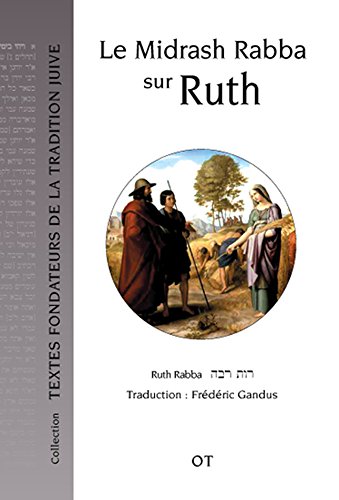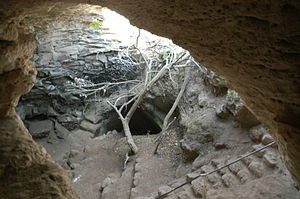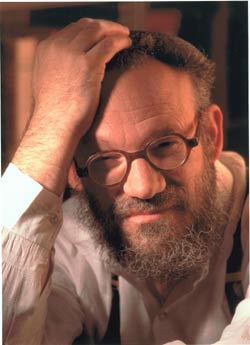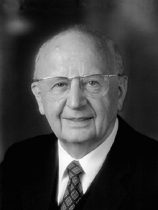The second of the three earliest references to the slain Messiah ben Joseph is a few lines further on in the same Talmud tractate, Sukkah 52a
Our rabbis taught: The Holy One, blessed be he, will say to Messiah ben David (May he reveal himself speedily in our days!), “Ask of me anything and I will give it to you,” as it is said, “I will tell of the decree [of the Lord],” etc. “This day I have begotten you. Ask of me and I will give you the nations for your inheritance” (Ps. 2). But when he will see that Messiah ben Joseph is slain, he will say to him, “Lord of the universe, I ask of you only life.”
Here the Messiah from the tribe of Joseph has been slain at some point towards the end time, but there is another Messiah involved in the drama, one who is descended from David who expresses concern over the death of his forerunner. We are not told how or why nor by whom the Messiah ben Joseph was killed. Readers or those who knew of this teaching of the rabbis presumably knew the details so there was no need to spell them out.
Interestingly the Messiah ben David in this passage has not till now made his mark in the end-time drama and in other passages (outside Sukkah 52a) his first act on his appearance is to forgo invitations to ask great things for himself and to request, instead, the resurrection of Messiah ben Joseph. In the Suk 52a, however, it appears that the sight of the dead Messiah ben Joseph stirs the Messiah ben David to ask for eternal life for himself — to which God replies that he already has eternal life (he had been living for ages in Rome unrecognised before the last days).
There are two clues in this passage that date the teaching to some time prior to 200 CE.
- The passage is written in Hebrew. See the previous post for the relevance of this: notice the Tannaitic period.
- The passage is introduced by the vague reference, “our rabbis taught” — instead of by a specifically named rabbi. Such an anonymous introductory formula is said to be typical of passages deriving from the Tannaitic period (the first two centuries of the current era) or earlier.
The last of the earliest three references to Messiah ben Joseph is from the same tractate, Sukkah 52b:
“And the Lord showed me four craftsmen” (Zech. 2.3). Who are these [four craftsmen]? Rav Hana bar Bizna said in the name of Rav Simeon Hasida: “Messiah ben David, Messiah ben Joseph, Elijah, and the Righteous Priest.”
This passage is not so easy to date on internal evidence though it is recorded as part of the later Aromaic tradition. The initial question is in Aramaic and the “ben” (son of) is Hebrew (rather than the Aramaic “bar”). External evidence helps more, says Mitchell. There are six other places where the “four craftsmen” appear, so let’s see how Mitchell analyses these variants to make an assessment on the date of the origin of the saying.
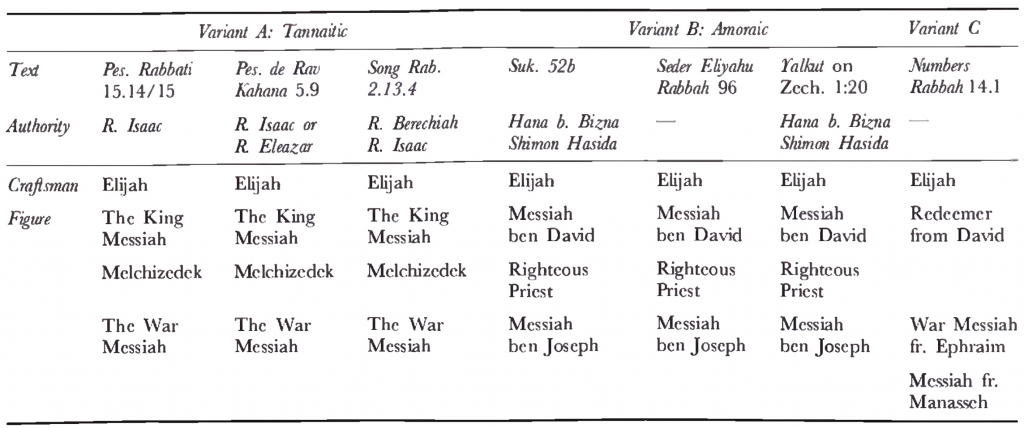
Note that there are three passages in Hebrew (that is, from the pre 200 CE Tannaitic period) and they all contain the same names in the same form:
- Elijah
- The King Messiah
- Melchizedek
- The War Messiah
Genesis Rabbah 99:2: “the War Messiah, who will be descended from Joseph;”
Midr. Tanhuma vol. I, p. 103a (§11.3): “in the age to come a War Messiah is going to arise from Joseph;”
Numbers Rabbah 14:1: “the War Messiah who comes from Ephraim;” [Ephraim is a son of Joseph]
Aggadat Bereshit, pereq 63 (A. Jellinek, Bet ha-Midrash [BHM], vol. IV, p. 87 [Leipzig, 1853–1877; photog. repr. Jerusalem, 1967]); “a War Messiah will arise from Joseph;”
Kuntres Acharon §20 to Yalkut Shimoni on the Pentateuch (BHM, vol. VI, p. 81): “a War Messiah is going to arise from Joseph;”
Gen.R. 75:6 applies Moses’ blessing on Joseph (Deut. 33:17) to the War Messiah.
The King Messiah of the early period (in Hebrew, before 200 CE) can be aligned with Messiah ben David that appear in what can be taken on balance as later texts (in Amorite, post 200 CE).
Since in biblical texts (Genesis 14:18-20 and Psalm 110:4) Melchizedek is known to be a priest, we can match the early reference to Melchizedek to the Righteous Priest in the later texts.
See the side box for the evidence that leads us to equate the War Messiah with Messiah ben Joseph.
Mitchell finds three key issues for dating the origin of the above third Messiah son of Joseph reference”: the Righteous Priest, the names in which the tradition is transmitted and the Qumran text 4Q175.
The Righteous Priest
The prominence given to the Righteous Priest alongside Messiah ben Joseph as one of the Four Craftsmen is an indicator of pre-Christian era origins of the teaching: Mitchell’s argument is as follows.
We saw in The Priestly Messiah and the Royal Messiah the Jewish belief in a Priest Messiah or an end-time priestly deliverer. Biblical passages on Melchizedek and the anointed priestly companion, Joshua ben Jehozadak, to the Davidic prince Zerubbabel in the Book of Zechariah may provide some foundation for a belief in a priestly saviour, but post-biblical writings bring such a figure into sharper focus. Here we are entering the Hasmonean era, the period following the Maccabean revolt, or the Second Temple era.
The Testament of the Twelve Patriarchs (see Priestly and Royal Messiahs) sets up a priest messiah from the tribe of Levi as the foremost messianic figure without any rival from the line of David. The Qumran literature (Dead Sea Scrolls) likewise contains passages that promote the priestly messiah, sometimes as superior to the Davidic messiah (1QSa 2.14-20).
If the priestly deliverer was a pre-eminent figure in the Hasmonean era, after Christianity emerged Jewish writings lost interest in him.
The priestly Messiah therefore enjoys pre-eminence in Hasmonean times. But at the turn of the era, when Judaism and Christianity diverge, although he is taken up by Christianity and Gnosticism, particularly as Melchizedek, Judaism knows him no more. The only other talmudic reference to Melchizedek, apart from this one in B. Suk. 52b, derogates the priesthood of the Genesis figure (B. Ned. 32b). Later midrashim feature the other “craftsmen” — ben David, ben Joseph and Elijah — with great frequency, but have no place for the priest. . . .
It therefore seems that the priestly messiah’s popularity rose with the Hasmonean dynasty who, keen to beget messianic acclaim, took Melchizedek’s title “Priest of El Elyon” from Gen. 14:18. But when their power was eclipsed and priestly status fell a century later with the Temple, the Priest Messiah, like his brothers, passed into obscurity, leaving only his former renown lingering among the “Four Craftsmen.” So the Righteous Priest’s presence among the “Four Craftsmen” must date from a time when he was still held in honor, that is, the Temple period. (Mitchell, p. 87f)
Variant source names
The Tannaitic texts cite relatively early names as the conveyors of the tradition. One source dates Rabbi Isaac to around 140 to 165 CE. The Rabbi Eleazar who is named in one of the early texts is dated even earlier, around 80 to 120 CE.
The names listed as sources for the four craftsmen tradition in the later Amoraic texts, Simeon Hasida and Hana bar Bizna, are dated to the late second and early third centuries.
Now the fairly short time-gap between these teachers hardly allows for the divergence between them. The different variants therefore derive from an earlier common source. In that case, we are taken back to the period before Isaac — or Eleazar– and, once again, find ourselves near the Temple era. (p. 88)
Qumran 4Q175 and a Joshua Messiah Continue reading “Continuing a case for an early Jewish belief in a slain messiah”
Like this:
Like Loading...

